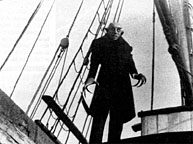Research with bite
Everyone wants to hear about Dracula. The Arts Council room was packed April 3 with students and faculty alike hoping for a glimpse of goth. Memorial professor of English Elizabeth Miller was invited by McGill and Université de Montréal to speak on the origins of Dracula, the vampire of Irish author Bram Stoker's novel.
 Still from the German film Nosferatu, 1922
Still from the German film Nosferatu, 1922 |
|
Other than a discreet coffin charm dangling from her necklace and little bat earrings, Miller looked like a suburban Mom and had the down-home no-nonsense attitude of those from out East.
There's no evidence that Stoker was particularly interested in the occult, but seemed to be a "two feet on the earth kind of guy," Miller said. Vampire fiction had been around for decades (such as the 1847 Varney the Vampire), and the folklore for centuries.
Dracula was published in 1897, after six years of research and writing. "It was not just slapped together," said Miller. Nonetheless, the vampire book has garnered a bad rap over the ages and been synonymous with kitsch. Some believe only "eccentric loafers" take the book seriously, yet in the 70s, literati brought the classic tale into academic discourse.
Dracula has spawned movies, books, ballets, even a musical, and much liberty has been taken with the original tale -- Miller estimates she's debunked 75 "Dracula" myths. (She says the 1978 BBC miniseries Count Dracula, which films the Whitby scenes on location, is fairly faithful to the original). Nowhere in the novel does Dracula have to avoid daylight, nor does he run around saying "I vant to suck your blood." He wasn't killed by having a stake pounded through his heart and, most certainly, Dracula did not originate in a nightmare that Stoker had after eating too much dressed crab.
Stoker's own notes were rediscovered in the mid-70s, and it's through these 85 pages of mishmash that scholars have pieced together Stoker's inspiration.
Miller, who sees herself as a literary detective, has been asked to edit his scrawly notes on tombstone headings, England's Whitby dialect (where part of the book takes place), plot and characters. Originally, Dracula was going to be from Steria, Austria, but then Stoker read Emily Gerard on the folklore of Transylvania (now in Romania, but in Hungary then), which sounded more exotic than Steria, Miller surmises. Gerard also wrote that the vampires were called "nosferatu," but subsequent research shows no such word exists. "It must've been a word misheard," Miller said. Possibly it was nosopharos -- bearer of plague; nesapherat -- suffering; or nekeratu -- evil one.
That Stoker was inspired by tales of Vlad the Impaler, the 15th-century Prince of Wallachia who used to dip bread in his victim's blood and called himself Dracula, "is a bunch of hogwash," Miller said. Stoker was going to name his protagonist Count Wampyr, but during research at the Whitby public library, he took out William Wilkinson's book on Wallachia and Moldavia in which there were a few references to Voivode Dracula (a.k.a. Vlad). A footnote revealed that Dracula means "devil" in Wallachian (which was given as a surname to those who exhibited courage, cunning or a cruel streak). "A mountain was made out of a molehill," said Miller on the link between the two Draculas. On a tangential note, just weeks before the novel was published, the title was changed from The Un-Dead to Dracula.
Stoker read Sabine Baring-Gould's Book of Were-Wolves (after a werewolf dies, it turns into a vampire), and Count Dracula's physical appearance owed much to werewolf stories, with his long fingernails, hairy palms and pointy ears. The Count could shapeshift into a bat, wolf or mist.
Miller's research gets plenty of reaction, particularly around Hallo-ween. Year round, she receives volumes of emails. "I have never written to a vampire before," started one. Occasionally, hopefuls ask her for advice on how to become a creature of the night.
For more toothsome fun, go to Miller's homepage at www.ucs. mun.ca/~emiller/, or Google "Miller" and "Dracula." Miller has participated in numerous radio and television documentaries, and is the author of several books, including: Dracula: Sense & Nonsense (2000), The Origins of Dracula (Illustrated), Dracula: The Shade and the Shadow (1998) and Reflections on Dracula (1997). The Third World Dracula Congress will take place in Sighisoara, Transylvania, Romania, May 15-18.

